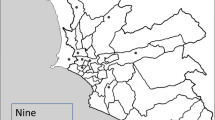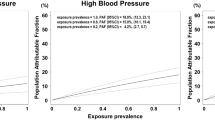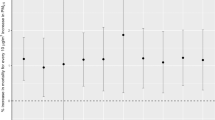Abstract
This study evaluated risks of emergency room visits (ERV) for all causes, circulatory diseases, and respiratory diseases associated with concentrations of particulate matter (PM10 and PM2.5) and Asian dust storms (ADS) from 2000 to 2008 in metropolitan Taipei. Cumulative 4-day (lag 0–3) relative risks (RR) and confidence intervals (CI) of cause-specific ERV associated with daily concentrations of PM10 or PM2.5 and ADS based on study period (ADS frequently inflicted period: 2000–2004 and less-inflicted period: 2005–2008) were estimated using a distributed lag non-linear model with Poisson distribution. Risks associated with ADS-inflicted season (winter and spring), strength (ratio of stations with Pollutant Standard Index above 100 is <0.5 or ≥0.5), and duration (ADS lasting for 1–3 days or ≥4 days) were especially evaluated. In non-linear models, an increase in PM10 from 10 μg/m3 to 50 μg/m3 was associated with increased risk of ERV for all causes and respiratory disease with cumulative 4- day RR of 1.18 (95% CI: 1.13, 1.24) and 1.37 (95% CI: 1.23, 1.54), respectively. From 2005 to 2008, the cumulative 4-day RR for an ERV related to an increase in PM2.5 from 5 μg/m3 to 30 μg/m3 is 1.21 (95% CI: 1.03, 1.41) for respiratory diseases, and 1.15 (95% CI: 1.08, 1.22) for all causes. In comparison with normal days, elevated ERV of all causes and respiratory diseases was also associated with winter ADS (with corresponding RRs of 1.10 (95% CI: 1.07, 1.13) and 1.14 (95% CI: 1.08, 1.21)) and shorter and less area-affected ADS (with corresponding RRs of 1.07 (95% CI: 1.01, 1.10) and 1.09 (95% CI: 1.03, 1.14)) from 2000 to 2004. Results of this study demonstrate that population health risk varies not only with PM concentration, but also with the ADS characteristics.
This is a preview of subscription content, access via your institution
Access options
Subscribe to this journal
Receive 6 print issues and online access
$259.00 per year
only $43.17 per issue
Buy this article
- Purchase on Springer Link
- Instant access to full article PDF
Prices may be subject to local taxes which are calculated during checkout




Similar content being viewed by others
Abbreviations
- ADS:
-
Asian dust storms
- CI:
-
confidence interval
- DLNM:
-
distributed lag non-linear model
- ERV:
-
emergency room visits
- Flu:
-
influenza
- PM10:
-
particulate matter <10 μm in aerodynamic diameter
- PM2.5:
-
particulate matter <2.5 μm in aerodynamic diameter
- RH:
-
relative humidity
- RR:
-
relative risk
- WS:
-
wind speed.
References
Sacks JD, Stanek LW, Luben TJ, Johns DO, Buckley BJ, Brown JS et al. Particulate matter-induced health effects: who is susceptible? Environ Health Perspect 2011; 119: 446–454.
Bell ML, Zanobetti A, Dominici F . Evidence on vulnerability and susceptibility to health risks associated with short-term exposure to particulate matter: a systematic review and meta-analysis. Am J Epidemiol 2013; 178: 865–876.
WHO. Ambient (outdoor) air quality and health, 2014.
AQICN Air Pollution in World: Real-time Air Quality Index Visual Map, 2014.
Cheng MT, Lin YC, Chio CP, Wang CF, Kuo CY . Characteristics of aerosols collected in central Taiwan during an Asian dust event in spring 2000. Chemosphere 2005; 61: 1439–1450.
Chen SJ, Hsieh LT, Kao MJ, Lin WY, Huang KL, Lin CC . Characteristics of particles sampled in southern Taiwan during the Asian dust storm periods in 2000 and 2001. Atmos Environ 2004; 38: 5925–5934.
Lee H, Honda Y, Lim YH, Guo YL, Hashizume M, Kim H . Effect of Asian dust storms on mortality in three Asian cities. Atmos Environ 2014; 89: 309–317.
Chien LC, Yang CH, Yu HL . Estimated effects of asian dust storms on spatiotemporal distributions of clinic visits for respiratory diseases in Taipei Children (Taiwan). Environ Health Perspect 2012; 120: 1215–1220.
Watanabe M, Yamasaki A, Burioka N, Kurai J, Yoneda K, Yoshida A et al. Correlation between Asian dust storms and worsening asthma in Western Japan. Allergol Int 2011; 60: 267–275.
Chan CC, Ng HC . A case-crossover analysis of Asian dust storms and mortality in the downwind areas using 14-year data in Taipei. Sci Total Environ 2011; 410–411: 47–52.
Yang CY, Chen YS, Chiu HF, Goggins WB . Effects of Asian dust storm events on daily stroke admissions in Taipei, Taiwan. Environ Res 2005; 99: 79–84.
Chan CC, Chuang KJ, Chen WJ, Chang WT, Lee CT, Peng CM . Increasing cardiopulmonary emergency visits by long-range transported Asian dust storms in Taiwan. Environ Res 2008; 106: 393–400.
Bell ML, Levy JK, Lin Z . The effect of sandstorms and air pollution on cause-specific hospital admissions in Taipei, Taiwan. Occup Environ Med 2008; 65: 104–111.
Perrone MG, Gualtieri M, Consonni V, Ferrero L, Sangiorgi G, Longhin E et al. Particle size, chemical composition, seasons of the year and urban, rural or remote site origins as determinants of biological effects of particulate matter on pulmonary cells. Environ Pollut 2013; 176: 215–227.
Krall JR, Anderson GB, Dominici F, Bell ML, Peng RD . Short-term exposure to particulate matter constituents and mortality in a national study of U.S. urban communities. Environ Health Perspect 2013; 121: 1148–1153.
Dai L, Zanobetti A, Koutrakis P, Schwartz JD . Associations of fine particulate matter species with mortality in the United States: a multicity time-series analysis. Environ Health Perspect 2014; 122: 837–842.
Pun VC, Yu IT, Ho KF, Qiu H, Sun Z, Tian L . Differential effects of source-specific particulate matter on emergency hospitalizations for ischemic heart disease in Hong Kong. Environ Health Perspect 2014; 122: 391–396.
Ito K, Mathes R, Ross Z, Nadas A, Thurston G, Matte T . Fine particulate matter constituents associated with cardiovascular hospitalizations and mortality in New York City. Environ Health Perspect 2011; 119: 467–473.
Zhou J, Ito K, Lall R, Lippmann M, Thurston G . Time-series analysis of mortality effects of fine particulate matter components in Detroit and Seattle. Environ Health Perspect 2011; 119: 461–466.
Chen YS, Yang CY . Effects of Asian dust storm events on daily hospital admissions for cardiovascular disease in Taipei, Taiwan. J Toxicol Environ Health A 2005; 68: 1457–1464.
Chen YS, Sheen PC, Chen ER, Liu YK, Wu TN, Yang CY . Effects of Asian dust storm events on daily mortality in Taipei, Taiwan. Environ Res 2004; 95: 151–155.
Yu HL, Yang CH, Chien LC . Spatial vulnerability under extreme events: a case of Asian dust storm's effects on children's respiratory health. Environ Int 2013; 54: 35–44.
Bureau of National Health Insurance, National Health Insurance Profile [in Chinese]. Taipei: Bureau of National Health Insurance, Department of Health, Executive Yuan, Republic of China, 2001.
Taiwan National Health Insurance Research Database, Longitudinal Health Insurance Database, 2014. Available at: http://w3.nhri.org.tw/nhird/en/Data_Subsets.html#S3 (accessed on 20 January 2014).
Taiwan Central Weather Bureau, The Central Weather Bureau Online Information, 2013. Available at: http://www.cwb.gov.tw/eng/index.htm (accessed on 1 March 2013).
Taiwan Environmental Protection Administration, Taiwan Air Quality Monitoring Network, 2013. Available at: http://taqm.epa.gov.tw/taqm/en/PsiAreaHourly.aspx (accessed on 1 March 2013).
The World Meteorological Organization, Climate and Land Degradation, 2005. Available at: http://www.wmo.int/pages/themes/wmoprod/documents/WMO989E.pdf (accessed on 5 February 2015).
de Longueville F, Ozer P, Doumbia S, Henry S . Desert dust impacts on human health: an alarming worldwide reality and a need for studies in West Africa. Int J Biometeorol 2013; 57: 1–19.
Liu TH, Tsai FJ, Hsu SC, Hsu CW, Shiu CJ, Chen WN et al. Southeastward transport of Asian dust: Source, transport and its contributions to Taiwan. Atmos Environ 2009; 43: 458–467.
US Environmental Protection Administration. Guideline For Reporting of Daily Air Quality - Pollutant Standards Index (PSI), North Carolina, USA, 1998.
Gasparrini A, Armstrong B, Kenward MG . Distributed lag non-linear models. Stat Med 2010; 29: 2224–2234.
Wang YC, Lin YK, Chuang CY, Li MH, Chou CH, Liao CH et al. Associating emergency room visits with first and prolonged extreme temperature event in Taiwan: a population-based cohort study. Sci Total Environ 2012; 416: 97–104.
Akaike H . Information theory and an entension of the maximum likelihood principle. In: Petrov BN and Csaki F (eds), 2nd International Symposium on Information Theory, Akademiai Kiado: Budapest, 1973, pp 267–281.
Chen SY, Lin YL, Chang WT, Lee CT, Chan CC . Increasing emergency room visits for stroke by elevated levels of fine particulate constituents. Sci Total Environ 2014; 473–474: 446–450.
Franklin M, Koutrakis P, Schwartz P . The role of particle composition on the association between PM2.5 and mortality. Epidemiology 2008; 19: 680–689.
Zanobetti A, Franklin M, Koutrakis P, Schwartz J . Fine particulate air pollution and its components in association with cause-specific emergency admissions. Environ Health 2009; 8: 58.
Mostofsky E, Schwartz J, Coull BA, Koutrakis P, Wellenius GA, Suh HH et al. Modeling the association between particle constituents of air pollution and health outcomes. Am J Epidemiol 2012; 176: 317–326.
Li P, Xin J, Wang Y, Wang S, Shang K, Liu Z et al. Time-series analysis of mortality effects from airborne particulate matter size fractions in Beijing. Atmos Environ 2013; 81: 253–262.
Li P, Xin J, Wang Y, Wang S, Li G, Pan X et al. The acute effects of fine particles on respiratory mortality and morbidity in Beijing, 2004-2009. Environ Sci Pollut Res Int 2013; 20: 6433–6444.
Yang CY, Tsai SS, Chang CC, Ho SC . Effects of Asian dust storm events on daily admissions for asthma in Taipei, Taiwan. Inhal Toxicol 2005; 17: 817–821.
Yu HL, Chien LC, Yang CH . Asian dust storm elevates children's respiratory health risks: a spatiotemporal analysis of children's clinic visits across Taipei (Taiwan). PLoS One 2012; 7: e41317.
Lin CY, Chou CCK, Wang ZF, Lung SC, Lee CT, Yuan CS et al. Impact of different transport mechanisms of Asian dust and anthropogenic pollutants to Taiwan. Atmos Environ 2012; 60: 403–418.
Dominici F, Daniels M, Zeger SL, Samet JM . Air pollution and mortality: estimating regional and national dose-response relationships. J Am Stat Assoc 2002; 97: 100–111.
Xie W, Li G, Zhao D, Xie X, Wei Z, Wang W et al. Relationship between fine particulate air pollution and ischaemic heart disease morbidity and mortality. Heart 2015; 101: 257–263.
Wang Y-C, Lin Y-K . Mortality associated with particulate concentration and Asian dust storms in Metropolitan Taipei. Atmos Environ 2015; 117: 32–40.
Kim SY, Peel JL, Hannigan MP, Dutton SJ, Sheppard L, Clark ML et al. The temporal lag structure of short-term associations of fine particulate matter chemical constituents and cardiovascular and respiratory hospitalizations. Environ Health Perspect 2012; 120: 1094–1099.
Pun VC, Tian L, Yu IT, Kioumourtzoglou MA, Qiu H . Differential distributed lag patterns of source-specific particulate matter on respiratory emergency hospitalizations. Environ Sci Technol 2015; 49: 3830–3838.
Li P, Xin J, Wang Y, Li G, Pan X, Wang S et al. Association between particulate matter and its chemical constituents of urban air pollution and daily mortality or morbidity in Beijing City. Environ Sci Pollut Res Int 2015; 22: 358–368.
Zanobetti A, Wand MP, Schwartz J, Ryan LM . Generalized additive distributed lag models: quantifying mortality displacement. Biostatistics 2000; 1: 279–292.
Stafoggia M, Cesaroni G, Peters A, Andersen ZJ, Badaloni C, Beelen R et al. Long-term exposure to ambient air pollution and incidence of cerebrovascular events: results from 11 European cohorts within the ESCAPE project. Environ Health Perspect 2014; 122: 919–925.
Acknowledgements
We would like to thank the Taiwan Ministry of Health and Welfare, Taiwan EPA, and Taiwan Central Weather Bureau for providing research data. The interpretation and conclusions contained herein do not necessarily represent the views of these agencies. This study was supported by grants from the Ministry of Science and Technology (MOST 103-2621-M-033-001, MOST 103-2633-M-033-002, NSC 102-2621-M-033-001, and NSC 102-EPA-F-005-001) of Taiwan.
Author information
Authors and Affiliations
Corresponding author
Ethics declarations
Competing interests
The authors declare no conflict of interest.
Additional information
Supplementary Information accompanies the paper on the Journal of Exposure Science and Environmental Epidemiology website
Rights and permissions
About this article
Cite this article
Lin, YK., Chen, CF., Yeh, HC. et al. Emergency room visits associated with particulate concentration and Asian dust storms in metropolitan Taipei. J Expo Sci Environ Epidemiol 26, 189–196 (2016). https://doi.org/10.1038/jes.2015.70
Received:
Revised:
Accepted:
Published:
Issue Date:
DOI: https://doi.org/10.1038/jes.2015.70



